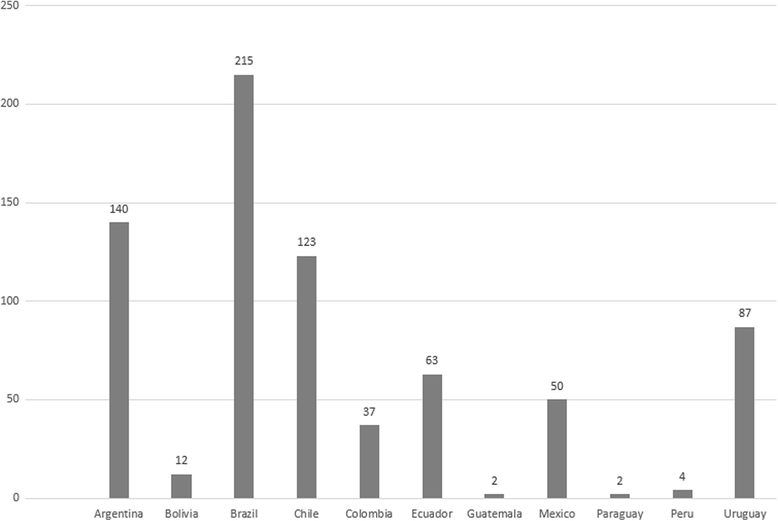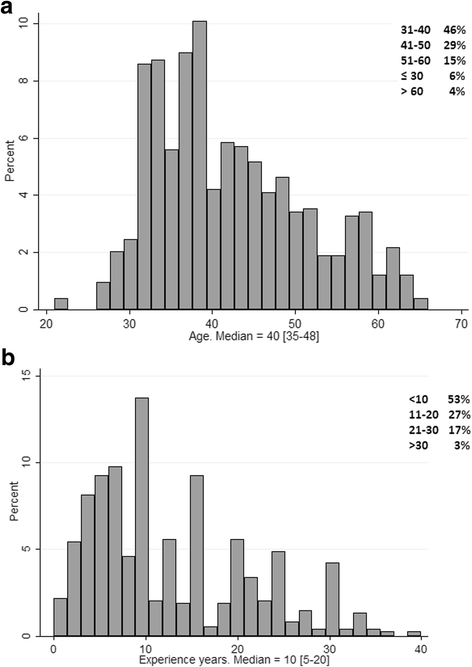The practice of intensive care in Latin America: a survey of academic intensivists
- PMID: 29463310
- PMCID: PMC5820791
- DOI: 10.1186/s13054-018-1956-6
The practice of intensive care in Latin America: a survey of academic intensivists
Abstract
Background: Intensive care medicine is a relatively young discipline that has rapidly grown into a full-fledged medical subspecialty. Intensivists are responsible for managing an ever-increasing number of patients with complex, life-threatening diseases. Several factors may influence their performance, including age, training, experience, workload, and socioeconomic context. The aim of this study was to examine individual- and work-related aspects of the Latin American intensivist workforce, mainly with academic appointments, which might influence the quality of care provided. In consequence, we conducted a cross-sectional study of intensivists at public and private academic and nonacademic Latin American intensive care units (ICUs) through a web-based electronic survey submitted by email. Questions about personal aspects, work-related topics, and general clinical workflow were incorporated.
Results: Our study comprised 735 survey respondents (53% return rate) with the following country-specific breakdown: Brazil (29%); Argentina (19%); Chile (17%); Uruguay (12%); Ecuador (9%); Mexico (7%); Colombia (5%); and Bolivia, Peru, Guatemala, and Paraguay combined (2%). Latin American intensivists were predominantly male (68%) young adults (median age, 40 [IQR, 35-48] years) with a median clinical ICU experience of 10 (IQR, 5-20) years. The median weekly workload was 60 (IQR, 47-70) h. ICU formal training was between 2 and 4 years. Only 63% of academic ICUs performed multidisciplinary rounds. Most intensivists (85%) reported adequate conditions to manage patients with septic shock in their units. Unsatisfactory conditions were attributed to insufficient technology (11%), laboratory support (5%), imaging resources (5%), and drug shortages (5%). Seventy percent of intensivists participated in research, and 54% read scientific studies regularly, whereas 32% read no more than one scientific study per month. Research grants and pharmaceutical sponsorship are unusual funding sources in Latin America. Although Latin American intensivists are mostly unsatisfied with their income (81%), only a minority (27%) considered changing to another specialty before retirement.
Conclusions: Latin American intensivists constitute a predominantly young adult workforce, mostly formally trained, have a high workload, and most are interested in research. They are under important limitations owing to resource constraints and overt dissatisfaction. Latin America may be representative of other world areas with similar challenges for intensivists. Specific initiatives aimed at addressing these situations need to be devised to improve the quality of critical care delivery in Latin America.
Keywords: Critical care; Health; Intensive care units; LMIC; Latin American; Manpower.
Conflict of interest statement
Ethics approval and consent to participate
Pontificia Universidad Católica de Chile was the only coordinating center. For this survey, the local ethics committee (Comité de Etica Clínica de la Facultad de Medicina de la Pontificia Universidad Católica de Chile) approved its content and waived the need for informed consent because physicians’ survey participation was voluntary, informed consent was assumed, and no patients were involved in this study.
Consent for publication
Not applicable.
Competing interests
The authors declare that they have no competing interests.
Publisher’s Note
Springer Nature remains neutral with regard to jurisdictional claims in published maps and institutional affiliations.
Figures



Similar articles
-
Organizational Issues, Structure, and Processes of Care in 257 ICUs in Latin America: A Study From the Latin America Intensive Care Network.Crit Care Med. 2017 Aug;45(8):1325-1336. doi: 10.1097/CCM.0000000000002413. Crit Care Med. 2017. PMID: 28437376
-
[Pediatric intensive care in Latin America].Med Intensiva. 2012 Jan-Feb;36(1):3-10. doi: 10.1016/j.medin.2011.07.004. Epub 2011 Sep 8. Med Intensiva. 2012. PMID: 21906846 Spanish.
-
Infant and child mortality in Latin America.Notas Poblacion. 1978 Apr;6(16):23-44. Notas Poblacion. 1978. PMID: 12335524 English, Spanish.
-
Workforce, Workload, and Burnout Among Intensivists and Advanced Practice Providers: A Narrative Review.Crit Care Med. 2019 Apr;47(4):550-557. doi: 10.1097/CCM.0000000000003637. Crit Care Med. 2019. PMID: 30688716 Review.
-
[The cholera epidemic in Latin America].Tidsskr Nor Laegeforen. 1992 May 30;112(14):1843-6. Tidsskr Nor Laegeforen. 1992. PMID: 1631846 Review. Norwegian.
Cited by
-
Low-dose radiotherapy for COVID-19 pneumonia treatment: case report, procedure, and literature review.Strahlenther Onkol. 2020 Dec;196(12):1086-1093. doi: 10.1007/s00066-020-01675-z. Epub 2020 Aug 20. Strahlenther Onkol. 2020. PMID: 32816059 Free PMC article. Review.
-
Advancing Neurosurgical Oncology and AI Innovations in Latin American Brain Cancer Care: Insights from a Center of Excellence.NeuroSci. 2025 Jun 10;6(2):54. doi: 10.3390/neurosci6020054. NeuroSci. 2025. PMID: 40559215 Free PMC article. Review.
-
Health inequities in the diagnosis and outcome of sepsis in Argentina: a prospective cohort study.Crit Care. 2019 Jul 9;23(1):250. doi: 10.1186/s13054-019-2522-6. Crit Care. 2019. PMID: 31288865 Free PMC article.
-
An Approach to Intensive Care Unit Rounds Utilizing 5, 10, and 15-Minute Strategies.ATS Sch. 2024 Jul 23;5(3):365-374. doi: 10.34197/ats-scholar.2023-0088PS. eCollection 2024 Sep 30. ATS Sch. 2024. PMID: 39371243 Free PMC article.
-
Core sepsis-related competencies for medical students: an international consensus by Delphi technique.BMC Med Educ. 2024 Jun 11;24(1):653. doi: 10.1186/s12909-024-05525-9. BMC Med Educ. 2024. PMID: 38862952 Free PMC article.
References
-
- Maso A. What challenges will Latin America face in 2016? Washington, DC: World Bank; 2016. https://www.worldbank.org/en/news/feature/2016/01/04/2016-desafios-latin.... Accessed 10 Jun 2017.
-
- Cecconi M, De Backer D, Antonelli M, Beale R, Bakker J, Hofer C, Jaeschke R, Mebazaa A, Pinsky MR, Teboul JL, Vincent JL, Rhodes A. Consensus on circulatory shock and hemodynamic monitoring. Task force of the European Society of Intensive Care Medicine. Intensive Care Med. 2014;40:1795–815. doi: 10.1007/s00134-014-3525-z. - DOI - PMC - PubMed
-
- Rhodes A, Evans LE, Alhazzani W, Levy MM, Antonelli M, Ferrer R, Kumar A, Sevransky JE, Sprung CL, Nunnally ME, Rochwerg B, Rubenfeld GD, Angus DC, Annane D, Beale RJ, Bellinghan GJ, Bernard GR, Chiche JD, Coopersmith C, De Backer DP, French CJ, Fujishima S, Gerlach H, Hidalgo JL, Hollenberg SM, Jones AE, Karnad DR, Kleinpell RM, Koh Y, Lisboa TC, et al. Surviving Sepsis Campaign: International Guidelines for Management of Sepsis and Septic Shock: 2016. Crit Care Med. 2017;45:486–552. doi: 10.1097/CCM.0000000000002255. - DOI - PubMed
MeSH terms
LinkOut - more resources
Full Text Sources
Other Literature Sources
Medical

